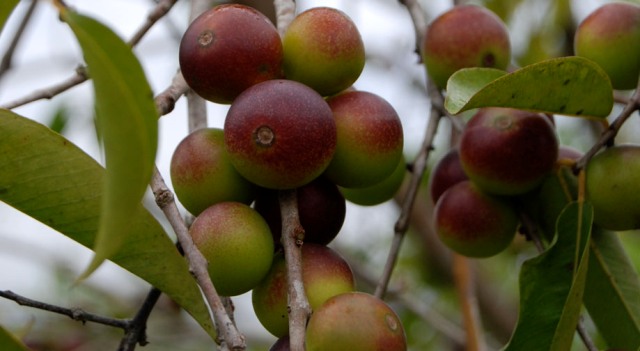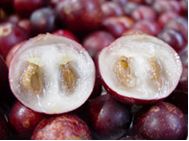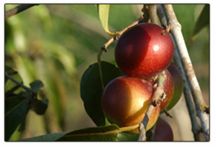Camu Camu Berry: Origins - Consumption - Nutrition Facts - Health Benefits
|
|
|
Contents
- Geographic origin and regions grown
- History of consumption
- Common consumption today
- Nutrition Facts: Vitamins, minerals and phytochemical components
- Health Benefits: Medicinal uses based on scientific studies
- Bibliography
Geographic Origins and Regions Grown

The camu camu berry is a commonly found in the South American rain forest. The shrub is found all the way from the North of Peru to the South of Brazil. The tree is heavily concentrated around the Amazon River.
The camu camu tree is most well known for its berry-like fruit that is widely consumed by both humans and animals. The tree has always grown widely along the swamp and river banks but because of its rich fruit, the farms have been developed in many areas of South America.
The berry which is grown on the camu camu plant is rich in Vitamin C and has been used for medicinal purposes by the Amazonian Indians for more than 700 years. Folklore tails from the Indian tribes indicate that the fruit can help treat infections, decrease pain, strengthen joints, and maintain longevity.
History of Consumption
The fruit from the camu camu tree has been consumed by numerous tribes in South America for years. The fruit has a dark red to purple color, a very soft tender flesh, and there is a large single seed inside the fruit.
The berry is the size of a grape but is more similar to the American cherry. Unlike the American cherry, the camu camu berry is not very sweet. In fact, many would describe the fruit’s taste as sour or acidic. Due to its awkward taste, it is almost never eaten simply as a fruit.
The camu camu tree grows easily in the presence of water and the tree has successfully been grown in many tropical parts of the world. Today, there are large farms in many European countries that grow the camu camu tree and the fruit can usually be found in fresh fruit markets. The camu camu tree was cultivated and the fruit harvested long before the Europeans came to South America, however.
Camu camu berries can be first spotted on the tree when it is approximately of 4-5 years old and the trees bear fruit once a year. The tree continues to bare fruits for as long as the tree is alive.
The camu camu fruit is handpicked by indigenous Amazonian natives during the fruit picking season. The fruit is a major source of vitamins for Amazonian natives.
Common Consumption Today

Even though the camu camu berry is very popular in most South American countries, it has not yet achieved the international fame like that of the American cherry. The reason for this is due to the expensive cost of shipping and marketing these fruits.
In addition, the number and variety of more delicious berries that can be eaten instead of the camu camu berry is endless. As a result, despite the high Vitamin C content of the camu camu fruit, marketing this product overseas has been unsuccessful.
Another difference between the camu camu berry and the American cherry is that the Camu berry is not eaten raw because it has a sour and acrid taste. Instead it is almost always used as a flavoring agent that is added to desserts, pies, ice cream, candy, beverages, sodas, or water.
Camu camu berry powder tastes more like lime, which also explains its sour taste. Although this fruits has a strange and unpleasant taste, the nutritional value of the fruit has been recognized and the fruit is dried, processed, and sold as a dietary supplement because of its vitamin C content (1).
For the past 4 decades, the natives failed to utilize the nutritional value of this fruit and were not able to establish proper agricultural farms. The majority of the fruit was handpicked randomly from trees along the river banks. This led to an erratic market where the fruit could not be properly exported to neighboring countries. The natives have always believed that growing this fruit in agricultural farms would endanger the Amazon forest.
Nutrition Facts: Vitamins, Minerals and Phytochemical Components

The camu camu fruit is rich in Vitamin C and contains 30 to 60 times more vitamin C than an orange or lemon. The camu camu berry is also an excellent source of calcium, phosphorus, potassium, iron, and various amino acids (2). Besides the vitamin and mineral content, the fruit is also rich in anthocyanins, amino acids, flavonoids and has very strong anti oxidant activity (3).
Health Benefits: Medicinal Uses Based on Scientific Studies
For years the scientific community has known that camu camu berries are rich in Vitamin C (2). In South America, the juice and the dried powder have been used as an astringent, anti-oxidant, anti-inflammatory, emollient cream. Native Indians have also utilized the plant to prevent numerous upper respiratory tract infections.
It is believed that the camu camu fruit may have anti-inflammatory activity, antibacterial properties, and the ability to stimulate the immune system. It may also protect the heart from atherosclerosis, delay aging, protect the skin from sun damage and prevent upper respiratory tract infections.
Despite, the obvious benefits of consuming the camu camu fruit as previously stated, harvesting and marketing this fruit is expensive. Until methods for cultivating the camu camu fruit improve, this is one fruit that will not be readily available in fresh fruits markets.
Bibliography
1. Bradfield, RB, Roca A. (1964) Camu Camu--A Fruit high in Ascorbic acid. Journal of the American Dietetic Association, 44:28-30.
2. Justi KC, Visentainer JV, Evelazio de Souza N, Matsushita M. (2000) Nutritional composition and vitamin C stability in stored camu-camu (Myrciaria dubia) pulp. Archivos Latinoamericanos de Nutricion, 50(4):405-8.
3. Zanatta CF, Cuevas E, Bobbio FO, Winterhalter P, Mercandante AZ. (2005) Determination of anthocyanins from camu-camu (Myrciaria dubia) by HPLC-PDA, HPLC-MS, and NMR. Journal of Agricultural Food and Chemistry, 53 (24):9532-5.
Disclaimer
Nutritiousfruit.com provides this website as a service. Although the information contained within the website is periodically updated, no guarantee is given that the information provided is correct, complete, and/or up-to-date. The materials contained on this website are provided for general information purposes only and do not constitute legal or other professional advice on any subject matter. Nutrtiousfruit.com does not accept any responsibility for any loss, which may arise from reliance on information contained on this website. The information and references in this website are intended solely for the general information for the reader. The content of this website are not intended to offer personal medical advice, diagnose health problems or to be used for treatment purposes. It is not a substitute for medical care provided by a licensed and qualified health professional. Please consult your health care provider for any advice on medications.
Didn't find what you were looking for? Search here...

Amazon Search Box:
Did you like this page?
|
|
|




